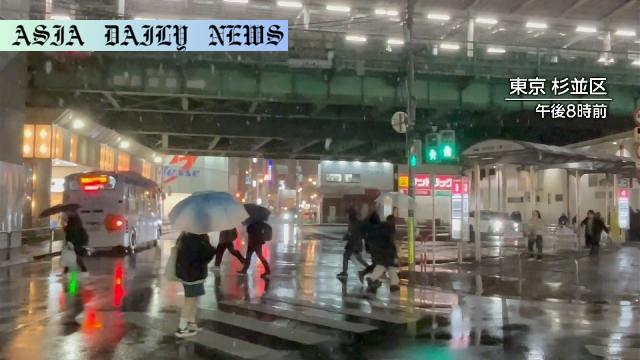Snow may accumulate as much as 10 centimeters in mountainous areas and up to 3 centimeters in Tokyo’s 23 wards through Sunday.
- Snow may accumulate up to 10 centimeters through Sunday in Kanto-Koshin, including Tokyo
- Flatlands of southern Kanto, including Tokyo’s 23 wards, may record up to 3 centimeters of snow.
- Officials urge caution due to potential icy roads and traffic disruptions.

Snow Warning in Kanto-Koshin Region
The Japan Meteorological Agency (JMA) has issued a significant snow alert for the Kanto-Koshin region, highlighting the possibility of heavy snow accumulation in both mountainous and flatland areas, including the central city of Tokyo. As per the weather forecast, the region is expected to experience adverse weather conditions caused by a low-pressure system coupled with a cold air mass descending along Honshu’s southern coast.
Accumulation levels are projected to vary across the area. Northern Kanto’s mountainous zones may anticipate up to 10 centimeters of snow, while the flatlands of the same areas might see 8 centimeters. Meanwhile, flatlands in southern Kanto could accumulate approximately 5 centimeters. Tokyo’s 23 wards, situated within the southern part of Kanto, may witness a lighter snowfall of up to 3 centimeters. Despite the seemingly small amount of accumulation in Tokyo, even minimal snowfall can cause notable disruptions in traffic and public safety due to icy roads.
Impact on Traffic and Precautions
Weather authorities have raised concerns regarding the spillover impact these weather conditions may impose on daily activities, particularly on transportation. Snowfall and icy conditions frequently lead to traffic delays, vehicle accidents, and flight cancellations in affected regions. Authorities recommend that local residents and commuters take precautionary measures, such as limiting unnecessary travel, adapting winter tires for vehicles, and wearing appropriate footwear to prevent slips and falls on icy sidewalks.
The JMA has emphasized the importance of staying informed through regular weather updates, as conditions may worsen without much notice. Preventive measures and careful planning, particularly regarding travel, could minimize disruptions. Individuals are also advised to have emergency kits ready and stay indoors during peak snowfall times to ensure safety.
Weather Pattern Analysis and Climate Impact
The snow forecast over the weekend stems from Japan’s typical winter climate patterns, heavily influenced by cold Siberian winds merging with coastal low-pressure systems. These systems often bring volatile weather conditions during the winter months. While snowfall serves as a seasonal norm for Japan’s mountainous belts, it is relatively rare in major metropolitan areas such as Tokyo. This rare occurrence highlights the significant interplay of atmospheric conditions such as descending polar air masses aligning with low-pressure movements.
Furthermore, unpredictable shifts in seasonal weather patterns could be linked to broader climate change developments. Scientists state that these rare occurrences of snow in areas like Tokyo may become part of Japan’s increasingly irregular weather profiles. This has raised questions about urban adaptability to sudden climatic shifts, underscoring the importance of well-prepared infrastructure and responsive strategies for unforeseen environmental changes.
Preparing for the Immediate Future
As the snowfall looms, local governments have initiated preparations such as deploying snowplows and de-icing agents in highly affected areas. Emergency management teams are on standby to respond to accidents, power outages, and other weather-related emergencies. Citizens are encouraged to stockpile essentials in case they are confined indoors due to severe weather. Connectivity for transportation services like trains, buses, and taxis remains under close surveillance to ensure minimal disruption.
In conclusion, while the Kanto-Koshin region may soon find itself under a picturesque blanket of snow, the accompanying risks cannot be ignored. Adequate planning, compliance with emergency advisories, and heightened caution will be critical in navigating the next 48-hour period. This extraordinary weather event can serve as a reminder of the unpredictability of nature and the necessity for community resilience in the face of challenges.



Commentary
The Rarity of Tokyo’s Snowfall
Snowfall in Tokyo is an infrequent yet captivating phenomenon, a stark reminder of weather’s unpredictable nature. While the city’s cosmopolitan charm often takes center stage, a blanket of snow transforms its dynamic streets into serene snapshots of winter stillness. But beyond the picturesque scene comes the reality of disruption. Tokyo, a city not particularly accustomed to snow, often grapples with its consequences, raising an important conversation about infrastructure resilience and urban adaptability to fluctuating climates.
The Importance of Preparation
The snowfall forecast is a stark reminder that preparation is key during such weather events. From municipal authorities ensuring infrastructure readiness to individuals gearing up for safe mobility, collective action plays an instrumental role in mitigating potential hardships. For instance, the proactive usage of winter tires, thoughtful itinerary adjustments, and reliance on accurate weather forecasts can significantly reduce accidents or delays.
It’s also essential to emphasize the role of shared public safety responsibilities. From businesses offering employees work-from-home options to government offices ensuring uninterrupted communication systems, a synchronized effort bolsters everyone’s ability to cope with challenges.
Climate Perspectives and Broader Impact
Lastly, rare events like snowfall in Tokyo offer a window into the ever-fluctuating dynamics of global climates. While some may attribute this change to natural weather variability, others correlate it with the broader implications of climate change. With the frequency of such anomalies predicted to increase globally, proactive investments in weather-resilient urban planning could not only safeguard cities but also foster a sustainable coexistence with nature’s unpredictability.
Ultimately, while the upcoming snow days may create temporary hurdles, they are also opportunities for Tokyo to reflect on its strategies and preparedness, ensuring future resilience against nature’s whims.